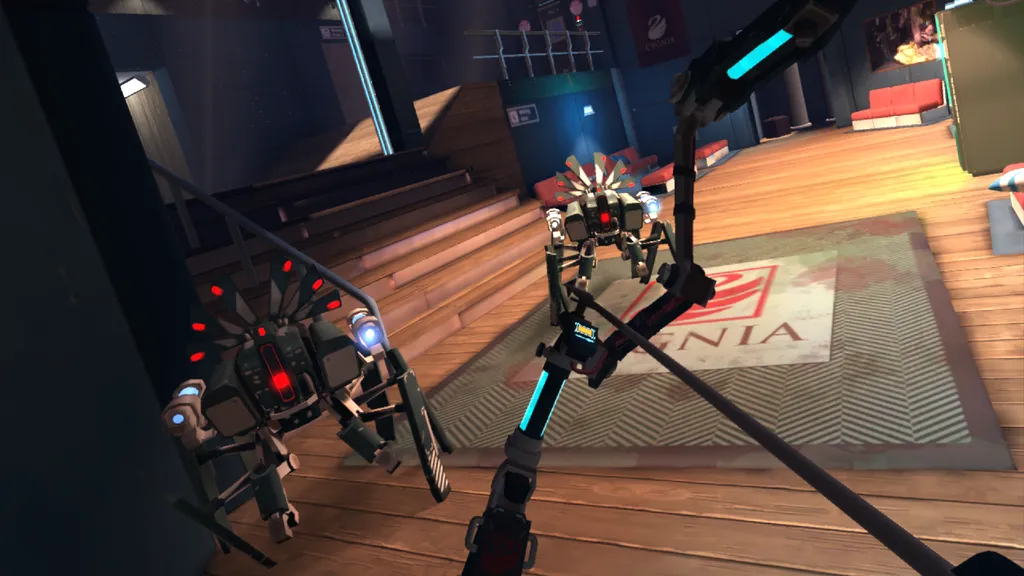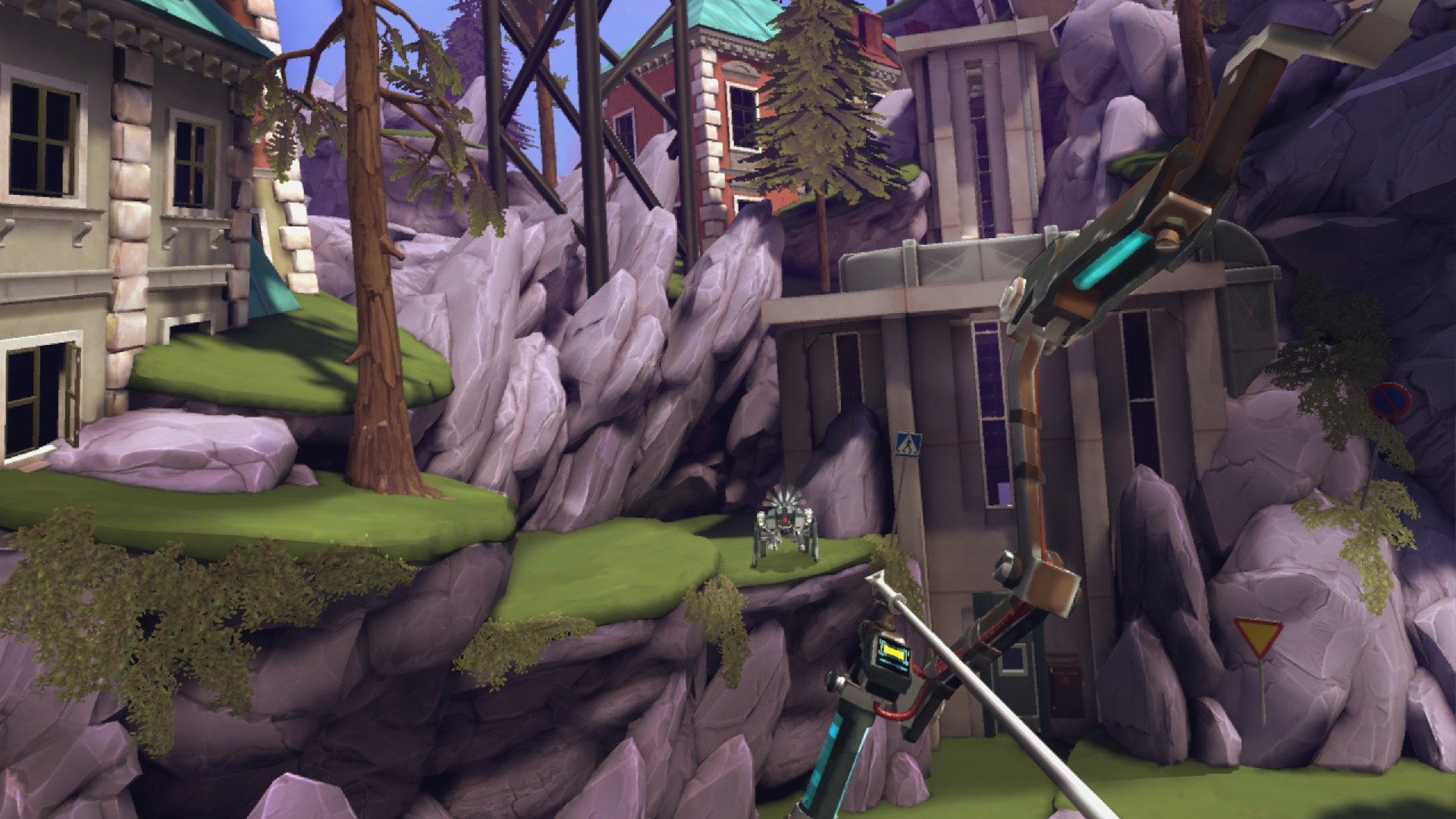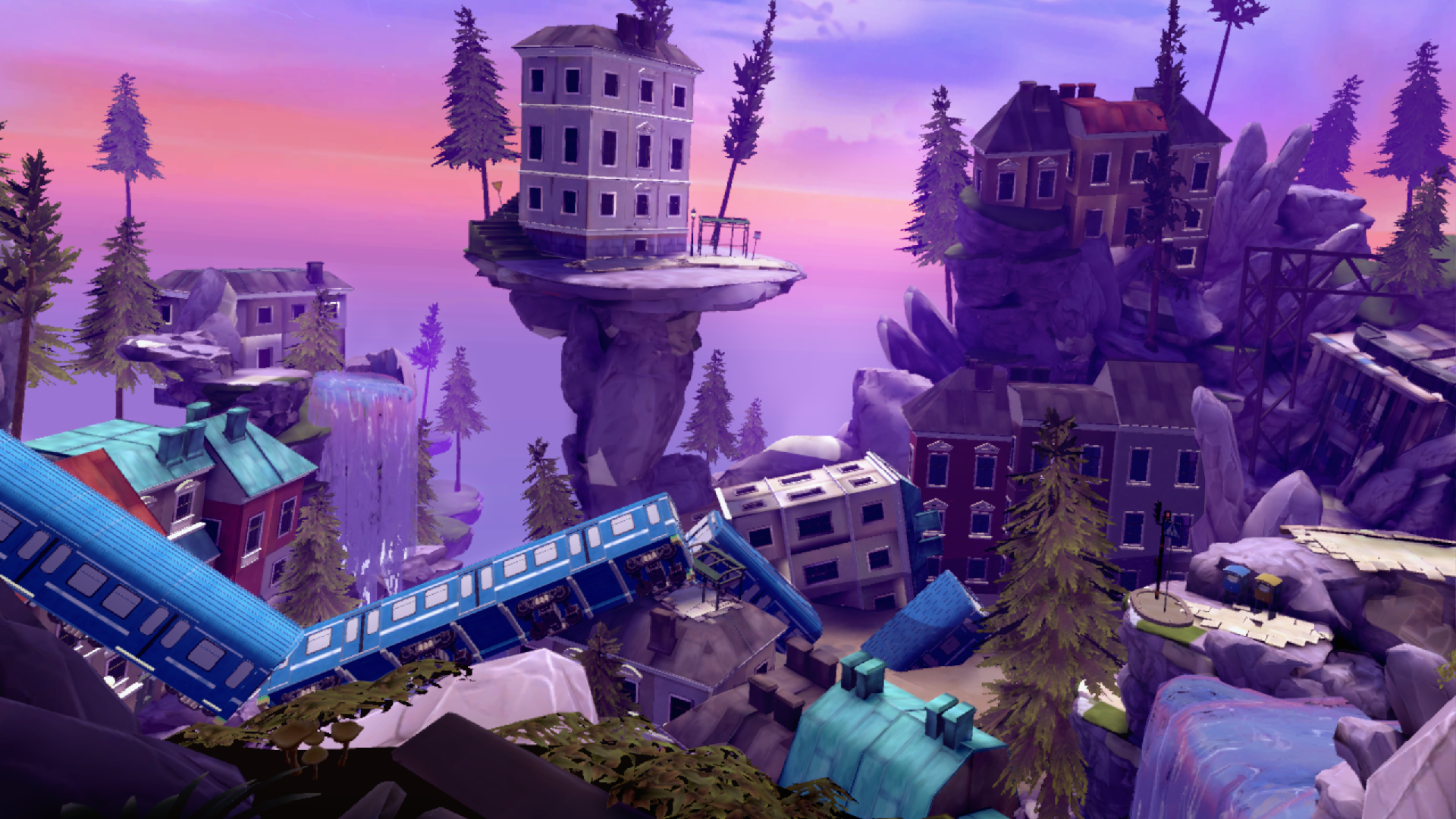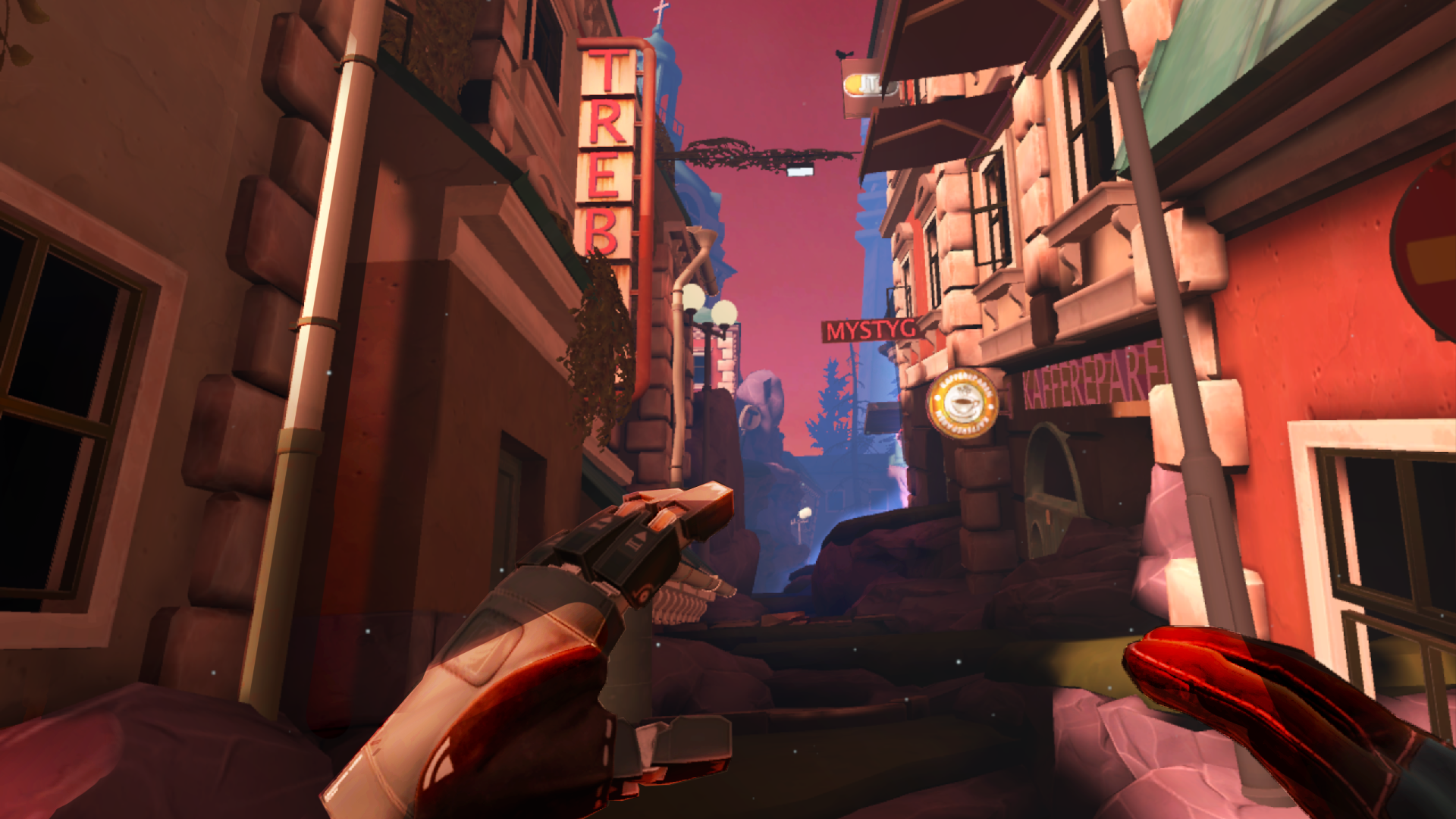Oculus Quest solves a lot of VR’s biggest issues. It removes the need for expensive PCs, cumbersome wires and external tracking. But there are inevitable trade-offs, the biggest of which being power. Quest’s mobile hardware (powered by a Snapdragon 835 chip) just isn’t as powerful as a PC or even a PS4. Without having extensive time with the device itself, we ultimately don’t know how big the differences between PC VR and Quest games will be, though we’ve had some small indications in the past few weeks. The only people that really know what the platform is capable of are the developers working on it.
So we asked one of them all about it.
Fast Travel Games is working on a port of its popular debut title, Apex Construct, for Quest. It’s a game that’s already withstood the comparisons between PSVR and PC VR but, with Quest, that gap only widens. Apex Construct has big, open levels with the occasional vista and plenty of interactive items. As you can see in the new screenshots released today, the game holds up pretty well visually. Fast Travel got a kind of headstart on Apex for Quest last year when it showcased a demo of the game running on mobile hardware, but the team says this ended up being a very different job to that. Read on for an in-depth look at its work.
On The Process Of Optimizing
Kristoffer Benjaminsson, CTO: So this time around we kind of did it the right way. We went through all the hurdles to get the assets in a way that would support running on a mobile device. We took some heavy decisions early on about what to scale down on. And to some extent we kind of scaled back too far. But at the same time we were struggling with the performance but it’s not due to textures or shaders. It’s mostly about the amount of stuff that we are drawing.
So it’s been a it’s been a heavy ride. Most of this stuff, at least to begin with, was automated. I mean we had a lot of systems in place for the PS4 and the PC versions that we modified and kind of reran and reran and reran to kind of simplify and optimize things to get going. And now we’re down to the creative. You know, what can we hide when and where and all the tricks in the book.
Erik Odheldahl, Creative Director: The idea is to keep the gameplay identical from the PC and PSVR version really. So all the logic is there. We basically tried to try and cram the same game–.
KB: It is the same game. I mean yes when you compare screenshots and you compare video you would definitely see that things are missing but from an immersion point of view from a gameplay perspective it is the same.
Andreas Juliusson, Marketing and Communications Manager: We actually we made I think five major updates to the initial launch in early 2018 on PC and PlayStation and all those updates will be in this Quest version of the game as well in addition to other improvements that have been made now for the Quest version as well since the last patch was released on PC/PSVR. So it’s very much a complete package we’re bringing. Even the DLC that we added a Cygnia cup challenge will be in this game for Quest as well.
Oskar Burman, CEO: But just to add to your first question I think the thing we did with the ARM was kind of a pre-production for us like we wouldn’t have been as easy to do this without that piece. That was very important for us to test and see if this would this be possible. And then we started working on real Quest stuff during the summer and autumn basically.
KB: Yeah. So we kind of got the knowledge and then we updated our tools and pipelines and assets and then we got going.
On If Optimization Was Harder Or Easier Than Anticipated
KB: I mean it’s always you get to the 80 percent really quick and you go like “Hey you know this is a walk in the park.” But the final 20 has been tough as it always is when a shipping game. I guess if we would have decided that we’re going to make major changes to the game and make a smaller game or a simpler game or rebuild stuff then it would have been a much easier ride.
But we wanted to provide the full Apex and an improved Apex. So I guess it’s slightly bigger than what we thought but I think we were fighting things that we didn’t really anticipate. We thought it would be about simplifying meshes and stuff which it wasn’t really. But we’re doing a lot of cool stuff in making sure that what you see looks about the same on Quest as it does on PS4. Kind of doing our homework and removing all the stuff that we don’t see for game performance.
EO: It’s a lot of optimizations that we didn’t have to do that we’re doing now. I mean maybe we should have done them for other platforms but we didn’t have to. And that’s usually how you ship games.
KB: I mean the Quest is great but it’s not as powerful as a PC of course. So I mean there are some things that we have to change and make tradeoffs to. But I think from a game perspective that is not the stuff that you think about.
EO: No. I mean the idea is that whether you play it on a Quest or you play it on your Rift or another PC device you should it should feel like the same game. And since we’re enabling now cross the cross-buy support as well for Quest and Rift, it feels it’s really important. I mean you will probably play or some people at least will play different versions. They should feel like the same game.
AJ: This is actually something we announced just a couple of days back that we’re supporting cross-buy by between these two versions.
KB: But then again I mean there were lots of unknowns. Would the tracking be as good as we wanted to be? You know, hands and head etc. How would that work? I think having done our homework with Microsoft Mixed Reality it kind of helped. So we had again the tools in place to handle a situation where you don’t show your hands or when you have to show your hands. So all-in-all I mean I’ve been pleasantly surprised about how much of the game that we have actually kept.
On PSVR Optimization Giving A Headstart On Quest
KB: Yeah I mean with the PlayStation we were not forced to come up with clever ways of getting that to run. Yeah. And what we’ve done with this is really just extended on top of that. So what’s interesting is that we haven’t done any or very few kinds of code optimizations because we did that work for the PS4.
On If Quest Is A Viable Platform For Other Developers
KB: Yeah absolutely. I mean tech wise you have a device that gives you all the kind of features that you’d expect from the high-end headset you have inside out tracking, you have hands, you have positional tracking, have a full field of view, you have quick storage, no loading etc.
This is going to be the nice thing. Gameplay wise as I said it’s hasn’t been an issue with you know getting everything we want. You just need to be smart about how you build your content. You really need to pay attention to detail and performance and that is the biggest thing.
OB: I’m very curious. This is the first generation game we built here and I’m curious for the new things we’re working on where we think about Quest from day one. That’s such a difference because then you can focus your efforts on the right things from the start. And then you can actually get a better output get in the end. So I think the second generation of games coming from us and from other players are gonna be more exciting in that sense because then as you know with hardware when it’s been out a while developers learn how to resource the processors in the right way and get maximum output from it. So Apex is fantastic but I’m super excited for the next thing we’ll show.
On If Quest’s Freedom Will Impact Game Design
EO: Yeah I mean potentially. I still think a lot of the same design challenges are still there. But it is room scale and in that sense. I think a lot of the design stuff we learned these past few years is still valid. But of course I think when we start looking at more untethered stuff we’re gonna start trying more and more things. Can we do this? What happens if we do that? And then playtest it on people see if they get it.
KB: But it’s gonna be super interesting to see how people use a device such as Quest. Will they still be seated or will they be standing? Will they make use room scale? Will they bring their devices and play you know in all kinds of places? How much area will they play in? So I think that will kind of guide us a lot with what we do. For now we’re still thinking about seated, standing, room scale. For sure I mean I think mobility is one of the biggest game changers to me that you bring the device with you and play VR wherever you want.
OB: Yeah a lot of players prefer playing Apex seated. So I think we’re still going to get there for both.
EO: We’re gonna look at stuff from a multi-platform angle anyway but just like we made Apex playable and a lot of fun in a room scale environment we still also made it playable sitting in front of your PSVR. And I think that philosophy is– we’re gonna stick to that now because I think well you want to be on as many headsets as possible. And play styles, yeah
On Where Quest Fits Into A Development Structure Going Forward
EO: I mean we’ll make certain technical choices early on in the process that will make our lives very much easier later on in the process. Design wise with a tethered headset it’s not so much that there’s an actual cable it’s that there’s usually a desk and chairs and a computer you have to be nearby etc. So not having to care about that for this particular platform, that is interesting because people can usually find a more open space.
KB: It does pose the question in covering the range from a device such as the Quest to a super high-end P is super wide. It kind of influences what type of game we make. Do we go for the graphical super high end? Or do we do something that we can actually get running on Quest? I mean with some of the places where we have been optimizing in the most is the biggest open spaces where the most action. And we can say well let’s not build that way again if we want to support the entire range. So I guess it’s gonna be up to each studio to figure out what type of games they want to make.
AJ: It will also be highly interesting to see how the Quest takes off from the launch and all leading through the rest of 2019 to 2020. There have been some experts claiming it will sell over a million copies this calendar year for example. If that’s the case you know it’s that it’s a pretty good power horse where there might be some commercial viability to create exclusively for Quest at some point. But it’s very hard today to sort of estimate or guesstimate how the Quest will do. We believe in it strongly. Yeah I mean it really does one thing important for the players which is removing the barriers of getting to gameplay. Yeah I mean it’s such a pickup and play even compared to Nintendo Switch for example, which no headset as of today has delivered on yet. So it has tremendous potential and would be very interesting to see how the sales take off and how Oculus themselves are actually delivering on the follow-up and the launch.
EO: And also sharing data about how it’s used. That will be super interesting for us to see and learn about.
OB: Yeah I think coming back to the accessibility point there. I’m curious to see what that does to sessions because I feel like it’s so much easier to carry this device than just put it on and have a couple of minutes of play time and then go do something else whereas with a Vive or Rift it’s more of a “I know I have an hour now I can play this game that’s deep and takes me you know it takes a long time to go through.” With this maybe you will see games that are tailored to short sessions as well because those games haven’t been really practical to use on current headsets.





























